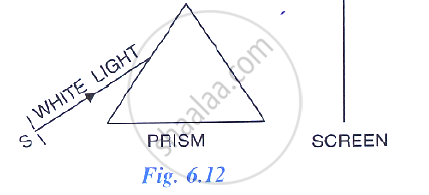Advertisements
Advertisements
प्रश्न
How does the deviation produced by a triangular prism depend on the colour (or wavelength) of light incident on it?
उत्तर १
Light of different colours have different speeds in a medium.
Therefore, the refractive index of glass (the material of prism) is different for different colours of light and the deviation caused by a prism is different for different colours of light.
Violet is deviated the most because in glass, speed of violet is least.
Red is deviated the least because in glass, speed of red is most.
उत्तर २
Because different colours have different wavelengths in the medium, the deviation that a prism produces depends on the colour (or wavelengths) of the light that impinges on it. Consequently, for various colours of light, the refractive index of glass (the prism's substance) differs, and the deviation brought about by the prism varies accordingly.
APPEARS IN
संबंधित प्रश्न
Which colour of white light travels fastest in glass?
In following diagram shows a thin beam of white light from a source S striking on one face of a prism.

A slit is placed in between the prism and the screen to pass only the light of green colour. What will you then observe on the screen?
Draw another diagram to show how the colours of spectrum of white light can be combined to give the effect of white light.
Light of different colours is deviated through different angles, by a prism. Explain the reason.
Give a reason, why the violet colour of white light deviated most and red colour of white light deviated least.
Explain, why quartz prism is required for obtaining the spectrum of ultra-violet light?
Comment on the statement: ‘When any ray of white light is incident on a glass prism, it simply disperses it into its seven constituent colours.
Write the approximate wavelength for red light.
The wavelengths for the light of red and blue colours are nearly 7·8 × 10-7 m and 4·8 × 10-7 m respectively.
Which colour has greater speed in glass?
